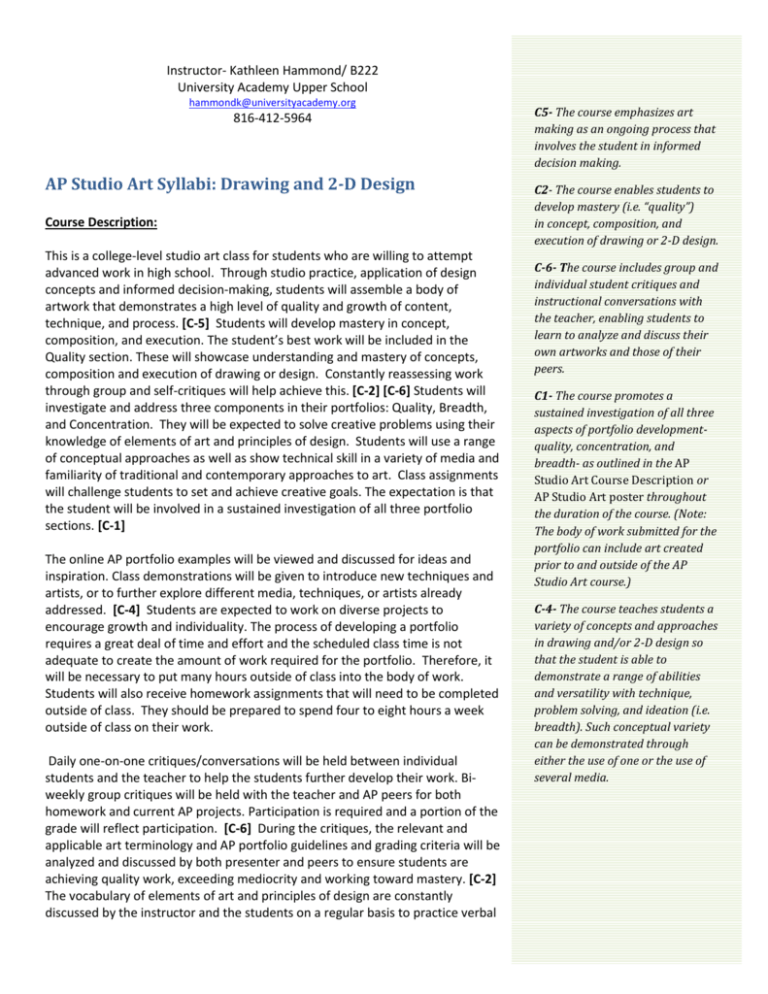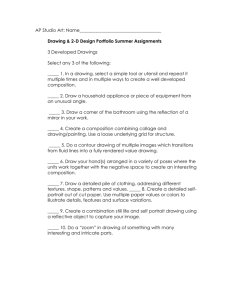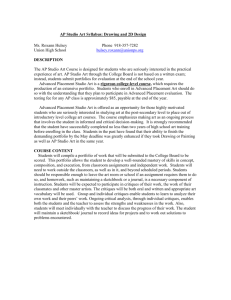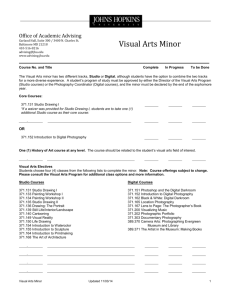C-4- The course teaches students a variety of concepts and
advertisement

Instructor- Kathleen Hammond/ B222 University Academy Upper School hammondk@universityacademy.org 816-412-5964 AP Studio Art Syllabi: Drawing and 2-D Design Course Description: This is a college-level studio art class for students who are willing to attempt advanced work in high school. Through studio practice, application of design concepts and informed decision-making, students will assemble a body of artwork that demonstrates a high level of quality and growth of content, technique, and process. [C-5] Students will develop mastery in concept, composition, and execution. The student’s best work will be included in the Quality section. These will showcase understanding and mastery of concepts, composition and execution of drawing or design. Constantly reassessing work through group and self-critiques will help achieve this. [C-2] [C-6] Students will investigate and address three components in their portfolios: Quality, Breadth, and Concentration. They will be expected to solve creative problems using their knowledge of elements of art and principles of design. Students will use a range of conceptual approaches as well as show technical skill in a variety of media and familiarity of traditional and contemporary approaches to art. Class assignments will challenge students to set and achieve creative goals. The expectation is that the student will be involved in a sustained investigation of all three portfolio sections. [C-1] The online AP portfolio examples will be viewed and discussed for ideas and inspiration. Class demonstrations will be given to introduce new techniques and artists, or to further explore different media, techniques, or artists already addressed. [C-4] Students are expected to work on diverse projects to encourage growth and individuality. The process of developing a portfolio requires a great deal of time and effort and the scheduled class time is not adequate to create the amount of work required for the portfolio. Therefore, it will be necessary to put many hours outside of class into the body of work. Students will also receive homework assignments that will need to be completed outside of class. They should be prepared to spend four to eight hours a week outside of class on their work. Daily one-on-one critiques/conversations will be held between individual students and the teacher to help the students further develop their work. Biweekly group critiques will be held with the teacher and AP peers for both homework and current AP projects. Participation is required and a portion of the grade will reflect participation. [C-6] During the critiques, the relevant and applicable art terminology and AP portfolio guidelines and grading criteria will be analyzed and discussed by both presenter and peers to ensure students are achieving quality work, exceeding mediocrity and working toward mastery. [C-2] The vocabulary of elements of art and principles of design are constantly discussed by the instructor and the students on a regular basis to practice verbal C5- The course emphasizes art making as an ongoing process that involves the student in informed decision making. C2- The course enables students to develop mastery (i.e. “quality”) in concept, composition, and execution of drawing or 2-D design. C-6- The course includes group and individual student critiques and instructional conversations with the teacher, enabling students to learn to analyze and discuss their own artworks and those of their peers. C1- The course promotes a sustained investigation of all three aspects of portfolio developmentquality, concentration, and breadth- as outlined in the AP Studio Art Course Description or AP Studio Art poster throughout the duration of the course. (Note: The body of work submitted for the portfolio can include art created prior to and outside of the AP Studio Art course.) C-4- The course teaches students a variety of concepts and approaches in drawing and/or 2-D design so that the student is able to demonstrate a range of abilities and versatility with technique, problem solving, and ideation (i.e. breadth). Such conceptual variety can be demonstrated through either the use of one or the use of several media. communication about the students’ own artworks as well as that of their peers, and should be foremost in the creative process. [C-5] The first semester will address the Breadth section of the portfolio while considering possibilities for the Concentration section. The Breadth section should address mastery of various media and/or techniques. The course will provide experiences in a variety of media and approaches to problem solving to express concepts and ideas. [C-2] Problem solving is an important component of this course. Students will use their sketchbooks to brainstorm ideas for artworks and build on and improve their work by reflecting on ongoing work. They will learn to use previously learned information in new and innovative ways to solve problems by exposure to various genres, artists, media, and techniques that will be introduced or reviewed through art history sessions of class time. They will break down observations and works into their component parts, examining and trying to understand the organizational structure and develop divergent conclusions. They will creatively apply prior knowledge and skills to produce new and original works. These discoveries and syntheses will be communicated and expressed through the use of a variety of concepts and approaches (ideation) in drawing, design, art media and techniques, as explored in their artworks. [C-4] The second term will be used to complete work on the Breadth while simultaneously working on the Concentration section. The Concentration section of the portfolio should demonstrate an investigation of a theme or an idea that is well planned and has personal interest to the student. Each student will present a written outline of their specific coherent plan of action or investigation, growth, and discovery involved with their compelling visual concept to the class. [C-3] [C-1] An after-hours Open Studio is designed to provide concentrated work time in the studio with a teacher. Open studio is required at least twice per month for a successful portfolio and attendance will be part of the final grade. In addition, frequent visits to museums and galleries are strongly encouraged. The teacher will be available to accompany students on Saturdays or Sundays upon request. This will help build a better understanding of concentrations, breadths, quality, as well as historical and contemporary approaches to art. Students are expected to use artistic integrity throughout the course. Work that is based on published photographs or the work of other artists must move beyond duplication to illustrate an original idea. If the student submits work that makes use of photographs, published images, and/or other artists’ works, substantial and significant development beyond duplication to ensure personal artistic ownership in the work must be shown. Plagiarism, using an image (even in another medium) that was made by someone else, is unethical and will not be allowed in this course. [C-7] Students will submit their required body of work along with their concentration essay to the College Board for grading and possible college credit. The deadline for submission is Friday, May 4, 2012. College credit is possible at many colleges and universities across the United States and in more than 60 other countries, in credit hours, advanced placement, or both. A list of facilities that accept AP exam scores is available at http://collegesearch.collegeboard.com/apcreditpolicy . C5- The course emphasizes art making as an ongoing process that involves the student in informed decision making. C2- The course enables students to develop mastery (i.e. “quality”) in concept, composition, and execution of drawing or 2-D design. C-4- The course teaches students a variety of concepts and approaches in drawing and/or 2-D design so that the student is able to demonstrate a range of abilities andstudents a C-4The course teaches versatility with technique, variety of concepts and approaches inproblem drawingsolving, and/orand 2-Dideation design so (i.e.the breadth). conceptual that studentSuch is able to variety can be demonstrated demonstrate a range of abilities through eitherwith the technique, use of one and versatility or the use of several media. (i.e. problem solving, and ideation breadth). Such conceptual variety C-3- The course enables can be demonstrated through students to develop a body of either the use of one or the use of work investigating a strong several media. underlying visual idea in drawing and/or 2-D design C2The course enables students to that grows out of a coherent develop mastery (i.e. “quality”) of action or investigation inplan concept, composition, and (i.e., a concentration execution of drawing or 2-D design. C1-The Thecourse coursepromotes promotesaa C1sustainedinvestigation investigationofofall allthree sustained three aspects of portfolio aspects of portfolio developmentdevelopment-quality, quality, concentration, and concentration, and breadthbreadthas outlined in the AP as outlined the APDescription Studio Art or Studio ArtinCourse Course AP AP StudioDescription Art poster or throughout Studio Art poster throughout the duration of the course. (Note: thebody duration of the course. for the The of work submitted (Note: The of work portfolio canbody include art created submitted for the portfolio prior to and outside of the APcan include created prior to Studio Artart course.) and outside of the AP Studio Art course.) C-7- The course teaches students to understand artistic integrity as well as what constitutes plagiarism. If students produce work that makes use of photographs, published images, and/or other artists’ works, the course teaches them how to develop Drawing Portfolio: The Drawing Portfolio is intended to address a very broad interpretation of drawing issues and media. Line quality, light and shade, rendering of form, composition, surface manipulation, the illusion of depth and mark- making are drawing issues that can be addressed through a variety of means, which could include painting, printmaking, mixed media, etc. Abstract and observational references may demonstrate drawing competence. The range of marks used to make drawings, the arrangement of those marks, and the materials used to make the marks are endless. Students will expand their drawing and two-dimensional design skills and advance their visual communication skills by exploring a variety of design processes and techniques, and compositional and aesthetic concepts. [C-4] [C-2] Students will produce a minimum of 24 works that satisfy the requirements of Quality, Concentration, and Breadth sections of the AP Studio Art Drawing portfolio. Consideration of the five quality pieces should be an ongoing process throughout the 2nd semester, and should be selected no later than April 19, so they can be prepared for submission. [C-1] 2-D Design Portfolio: This portfolio is intended to address two-dimensional design issues. Design involves purposeful decision making about how to use the elements of art and principles of design in an integrative way. The principles of design (unity/variety, balance, emphasis, contrast, rhythm, repetition, proportion/scale, figure/ground relationships) can be articulated through the visual elements (line, shape, color, form, value, texture, and space). They help guide artists in making decisions about how to organize an image on a picture plane in order to communicate content. Effective design is possible whether one uses representational or abstract approaches to art. For this portfolio, students are asked to demonstrate mastery of 2-D design through any two-dimensional medium or process, including, but not limited to, graphic design, digital imaging, photography, collage, fabric design, weaving, fashion design, fashion illustration, painting and printmaking. Students will expand their two-dimensional design skills and advance their visual communication skills by exploring a variety of design processes and techniques, and compositional and aesthetic concepts. [C-4] [C-2] Students will produce a minimum of 24 works that satisfy the requirements of Quality, Concentration, and Breadth sections of the AP Studio Art 2-D Design portfolio. Consideration of the five quality pieces should be an ongoing process throughout the 2nd semester, and should be selected no later than April 19, so they can be prepared for submission. [C-1] C-4- The course teaches students a variety of concepts and approaches in drawing and/or 2-D design so that the student is able to demonstrate a range of abilities and versatility with technique, problem solving, and ideation (i.e. breadth). Such conceptual variety can be demonstrated through either the use of one or the use of several media. C2- The course enables students to develop mastery (i.e. “quality”) in concept, composition, and execution of drawing or 2-D design. C1- The course promotes a sustained investigation of all three aspects of portfolio development-quality, concentration, and breadth- as outlined in the AP Studio Art Course Description or AP Studio Art poster throughout the duration of the course. (Note: The body of work submitted for the portfolio can include art created prior to and outside of the AP Studio Art course.) C-6- The course includes group and individual student critiques and instructional conversations with the teacher, enabling students to learn to analyze and discuss their own artworks and those of their peers. Both Drawing and 2D Design: Student Objectives: Maintain a strong work ethic. Work through and solve visual problems effectively and independently. Refine the ability to draw/render what you see. Understand how art elements and design principles communicate content. Increase awareness of the creative process as being investigative and continuous. Increase knowledge of art tools and materials. Pursue the art making process with passion and fervor. Create a portfolio that showcases mastery, quality, and growth as an artist. C-6- The course includes group and individual student critiques and instructional conversations with the teacher, enabling students to learn to analyze and discuss their own artworks and those of their peers. C-7- The course teaches students to understand artistic integrity as well as what constitutes plagiarism. If students produce work that makes use of photographs, published images, and/or other artists’ works, the course teaches them how to develop their own work so that it moves beyond duplication. Grading: Class participation (Staying on task, using every minute wisely, portfolio completion) Artwork Grades Meeting Project Deadlines with written assessments Monthly Class Critique participation (Prepared for presentation and offer constructive critique of peers) Open Studio Participation Consistent use of sketchbook – checked bi-weekly (Fill the pages and experiment!) 20% 40% 10% 20% 5% 5% Assessments: The students will discuss with the teacher and examine, analyze and integrate the elements of art through the principles of design in each of their artworks. Emphasis will be placed on discovering strengths and projects needing additional work as well as compositions or works that are formally strong. [C-6} Throughout the student’s work and upon completion of the work, the appropriate AP Studio Art Scoring Guideline (Drawing or 2D) should be visited and assessed in relation to the work. Both the Quality and Breadth or Concentration sections should be addressed. A written assessment addressing these scoring guidelines should be turned in with each artwork on the due date and will be discussed during critiques. (Guideline sheets attached.) [C-7] Reassessment: If an assignment is determined to need reworking for improvement, the student may continue to work on that artwork. The given score will remain until the work is turned in again. The score earned after improvement will replace the original score if completed that quarter. The reworked project must be turned in with the instructor’s original remarks for eligibility of reassessment. 2D Design Issues- Track each artwork with this guide Balance Emphasis/ Contrast Harmony/ Unity Variation/ Complexity Gradation Movement/ Rhythm Repetition Figure/ Ground Relationship Proportion/ Scale Color Value Line Texture Shape/Form Space Drawing- Score the following from 1-6 or NA if not applicable Line Quality Light and shade Rendering of form Composition Surface Manipulation Illusion of Depth Mark Making In addition to using these charts to monitor your work, constantly refer to the AP Scoring Guidelines for the applicable artwork. Bibliography: Arnason, H.H. History of Modern Art: Painting, Sculpture, Architecture, Photography. 4th ed. New York: Harry N. Abrams, 1998. Print. Borgeson, Bet. The Colored Pencil, Key Concepts for Handling the Medium. Revised Edition. Watson-Guptill Publications, 1995. Print. Brooke, Sandy. Hooked On Drawing! Paramus, NJ: Prentice Hall, 1996. Print. Cole, Alison. Perspective. London: DK Ltd., 1992. Print. Dodson, Bert. Keys to Drawing. Cincinnati: North Light, 1990. Print. Field, Richard S. Jasper Johns Prints 1960-1970. Philadelphia: Philadelphia Museum of Art, 1970. Print. Fleming, William. Arts & Ideas, Eighth Edition. Fort Worth: Holt, Rinehart and Winston, Inc., 1991. Print. Hale, Robert Beverly and Terence Coyle. Anatomy Lessons From the Great Masters. New York: Watson-Guptill, 2000. Print. Janson, H.W. and Anthony F. Janson. History of Art, Sixth Edition. New York: Harry N. Abrams, Inc., 2001. Print. Keller, Horst. The Great Book of French Impressionism. Netherlands: Greenwich House, 1982. Print. Kendall, Richard. Van Gogh’s Van Gogh’s, Masterpieces from the Van Gogh Museum Amsterdam. Washington: National Gallery of Art, 1998. Print. Mittler, Gene A., Ph.D. and James D. Howze. Creating and Understanding Drawings, Fourth Edition. The McGraw-Hill Companies, Inc., 2006. Print. Okamoto, Naomi. Japanese Ink Painting, The Art of Sumi-E. New York: Sterling Publishing Co. Inc., 1996. Print Lucie-Smith, Edward. The Thames and Hudson Dictionary of Art Terms. London: Thames and Hudson, Ltd, 1996. Print. Nice, Claudia. Creating Textures in Pen & Ink with Watercolor. Cincinnati: North Light Books, 1995. Print. Roy Lichtenstein, Landscapes in Chinese Style. Hong Kong: Hong Kong Museum of Art, 1998. Print. Smith, Ray and Michael Wright and James Horton. An Introduction to Art Techniques. New York: DK Publishing, 1999. Print. Stark, Freddy, Ph.D. Original illustrations by Henry Gray, adapted by Helen I. Driggs. Philadelphia: Running Press, 1991. Print. Strickland, Carol Ph.D and John Boswell. The Annotated Mona Lisa, A Crash Course in Art History From Prehistoric to Post-Modern. Kansas City: Andrews and McMeel, 1992. Print. The 20th Century Art Book. London: Phaidon Press Ltd., 2000. Print. The American Art Book. London: Phaidon Press Ltd., 1999. Print. The Complete Cartoons of The New Yorker. Mankoff, Robert, Ed. New York: Black Dog & Leventhal Publishers, 2006. Print. The Essential series. New York: Wonderland Press, 2001. Print. Werner, Alfred. Degas Pastels. . Watson-Guptill Publications, 1978. Print. Zollner, Frank. Leonardo daVinci. New York: Barnes and Noble, Inc., 2004. Print. Art Magazines: Art in America, ArtNews, Artists in Their Time, Scholastic Art _____________________________________________________________________________________ Signature Required !!!!!!!!!!!!!!!!!!!!!!! !!!!!!!!!!!!!!!!!!!!!! !!!!!!!!!!!!!!!!!!!!!!! !!!!!!!!!!!!!!!!!!!!!!! (100 points) diligence. Signature confirms that you are committed to this class, that you will put in the necessary extra hours with due Student name and signature _____________________________________________________________ Parent/Guardian name and best contact information _____________________________________________________________________________________ Parent signature _______________________________________________________________________








